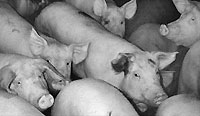Concentrated Animal Feeding Operations
 Minnesota, USA - Concentrated Animal Feeding Operation. Giant livestock operations are a growing public health threat all across the nation. These corporate-controlled units – where tens of thousands of animals are “produced” in factory-like settings – are polluting America’s water and air.
Minnesota, USA - Concentrated Animal Feeding Operation. Giant livestock operations are a growing public health threat all across the nation. These corporate-controlled units – where tens of thousands of animals are “produced” in factory-like settings – are polluting America’s water and air.What are the health impacts of livestock factories?
Because livestock factories produce and store large quantities of animal waste in leak-prone lagoons, America’s water is at risk. A 10,000-hog operation produces as much waste in a single day as a town of 25,000 people. Manure spills, fish kills and poisoned water supplies have become a fact of life for too many rural communities. Unhealthy tap water has sickened people across the Midwest and Southeast. And when the waste from a livestock unit contaminated the water in Indiana, public health officials confirmed that it resulted in six local women experiencing miscarriages.
Livestock factories also pose a threat to our air quality. In Texas, a child went into respiratory arrest and had to be rushed to the hospital due to airborne manure from a giant cattle operation. And in Minnesota, pre-schoolers were sickened when the odor from a hog waste lagoon brought high levels of hydrogen sulfide in their classroom.
Sustainable livestock production is an alternative to standard production methods which provides a reasonable rate of return to the farmer while taking into account the impacts that livestock operations have on local communities and the environment. To be sustainable, an intensive livestock operation must consider the availability of resources (feed, land, water), the ability of the environment to safely absorb wastes, human and animal health concerns, and the direct effect that the operation will have on the local community.
In its current form, the CAFO industry is not sustainable. Here are some reasons why:
Overstocking and environmental contamination: In the days of small “Mom and Pop” farms, it was natural to let animals dispose of their waste on farm land as a way to supply cheap fertilizer to the soil. Now, however, the higher concentration of animals in CAFOs means waste (especially nitrogen and phosphorus) is generated and cycled in excess through the air, water, and land, overburdening the ecosystem’s capacity to utilize it. For example, the amount of land needed to efficiently distribute the manure generated in a typical intensive cattle feedlot is 1000 times larger than the feedlot itself. Most CAFOs do not have this much land available for manure application, so the excess may be over-applied to a smaller area. To make matters worse, there are few national and state regulations that set specific requirements for applying manure on land. Texas regulations state that land application of wastewater from lagoons “shall not exceed the nutrient uptake of the crop coverage,” however this amount is calculated on a case-by-case basis. And waste application may still exceed crop requirements if a CAFO submits a “Nutrient Utilization Plan” which justifies its waste management practices.
Human health impacts: Industries that pose significant threats to human health are not sustainable. The health impacts of CAFOs can be seen at many levels. Dust and odors contribute to respiratory problems in workers and nearby residents. Contamination from runoff or lagoon leakage degrades water resources and can contribute to illness by exposing people to wastes and pathogens in their drinking water. Finally, the misuse of antibiotics in animal production systems results in the development of antibiotic-resistant pathogens which may be passed through the food chain to humans.
Negative impact on local communities: CAFOs that contaminate air and water resources have a direct impact on the health and well-being of nearby communities. At the same time, odors from CAFOs can drive down property values and force some long-time residents to leave, as noted in this report. And the evidence is unclear whether CAFOs really do enhance the local economy. Larger, more mechanized farms may actually worsen community conditions because they may hire migratory agricultural workers for low wages (and with no promise of adequate housing), purchase feed and supplies outside of the local area (thereby draining economic resources away from the community), and eventually drive out family farms that can no longer compete.
What could be expected from a sustainable livestock production system? It can be envisioned as an integrated and holistic approach: human labor and resources are substituted for capital and commercial inputs; externalities such as pollution ‘costs’ are considered and weighed against the economic benefits (i.e. profit) of the facility; stocking densities do not compromise animal health and well-being; waste production does not exceed the nutrient-absorbing capacity of the surrounding land or jeopardize water quality; forage crops are grown on-site or nearby to promote self-sufficiency and less reliance on outside feed shipments; and rural communities are strengthened and empowered. Given the commitment and the will, livestock producers have the resources and knowledge to begin this transition to sustainability today.
To see how Klean Industries helps farms become more environmentally sustainably, please click here.
You can return to the main Market News page, or press the Back button on your browser.

